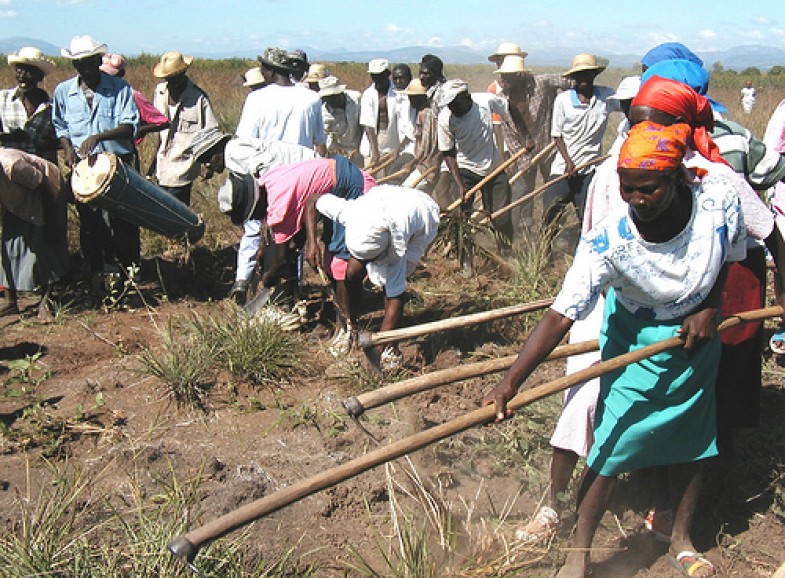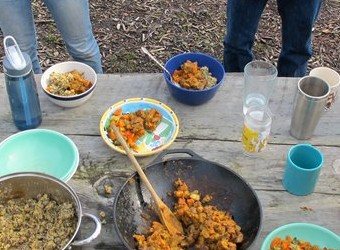In Haiti—but not just in Haiti—donors and politicians love infrastructure projects. They’re tidy packages with a clear start and a finish—or so they appear. First a blueprint. Then cement. Mix it up and repair a drainage ditch, build a rock wall to retain soil or a school. The sponsoring agency—be it CARE, the European Union, USAID, World Vision or a long list of others—then can erect a billboard announcing the project. Cut the ribbon and snap the photo. Pass the new infrastructure over to the beneficiary. Voila la modernization!
But what if it wasn’t that simple? What if infrastructure projects sometimes did more harm than good?
If the project is meant to become part of a community’s commons, a legacy for future generations, then cultivating community ownership in the broadest sense is essential. A number of factors determine whether new infrastructure will function as a commons. Who will manage and repair the new public works? Does the new infrastructure leave community organizations stronger than before or weakened by new challenges? In numerous case analyses and program evaluations, development experts like Massachusetts Institute of Technology (MIT) Judith Tendler have discovered that these critical questions are often an afterthought in infrastructure projects. In Haiti, the rush to quickly spend billions of donated aid means that these afterthoughts often receive even shorter shrift than in other places.
Retaining Soil and Retaining Community Leaders
On a recent trip to Haiti, I saw a weathered piece of sheet metal touting a USAID soil conservation project in Bayonnais. The stone walls built through a cash-for-work program were intended to retain soil on a denuded hillside that erodes in the rains. Who can argue with an improvement like that?
Had they been consulted, the local small farmer organization, the Peasant Movement of Bayonnais (MPB in Kreyol) would have told USAID that May to December is a lousy time to recruit farmers to work on these projects. They would have protested that it’s unfair to tempt them with cash work, when they ought to be tending their fields. They would have asked USAID to ensure that this project reinforces local leadership rather than undermines it through onerous administrative requirements and committee structures. The MPB would have advised weaving the new terraces into a broader environmental program that includes reforestation – and ensures that the saplings survive Haiti’ s brutal dry season. They would have defined who owns, manages and benefits from this new commons after the cement dries.
For over two decades, this membership organization has battled hunger in the region, training farmers in agroecological techniques to restore depleted land, increase yields in sweet potato and manioc crops and protect water sources. Their volunteer leaders are a critical part of the social infrastructure that ensures the success of their agricultural development projects.
USAID agronomists with the WINNER program introduce technology packages to modernize agriculture in places like Bayonnais. They similarly seek to upgrade management systems. But farmers may be resistant to change, WINNER agronomist Philippe Bellerive said. “At times they are stubborn and it’s true that we are strict,” Bellerive said. “We won’t agree to support their old farming methods that don’t work and leave them hungry.”
After through discussions with Bellerive and members of the peasant organization, it became painfully clear that while they share a vision of overcoming hunger, they otherwise live in parallel universes. Their farming and teaching methods vary greatly. This disconnect has serious consequences because the two groups often work at cross purposes. Local farmers may say: “Nah, I won’ t collect and pile brush to conserve soil” – a low cost technique that the MPB has found to be effective at retaining soil and restoring its fertility. “No need to break my back nurturing saplings to trees. USAID will be along soon enough and pay me to construct stone walls. No need to undertake a community project with my neighbors, attend a training and sit through another hot planning meeting.”
Every each development project cooked up in an air-conditioned office on an engineer’s desk, makes it gets harder to encourage volunteer participation and leadership in local organizations—the bottom line managers of a common.
Bringing Government Back
And what about calling on government to protect the commons? Their role is sadly shrunken in Haiti. A long history of dependency and corruption, excessive centralization in Port au Prince, gutted ministries because of government cutbacks and a flood of NGO projects that circumvent public agencies have weakened the public sector. The safety net for Haitians comes from neighbors, family members working in the United States and local organizations like MPB. There is much work to be done to bring government back to playing an effective role.
Alfredo Mena, the Dominican-born Interamerican Institute for Cooperation on Agriculture representative to Haiti, estimates that there are 9,000 NGOs in Haiti. And they are all welcome to contribute to Haiti’s development, he said. But IICA and others have worked hard with the Haitian Ministry of Agriculture to craft a national plan for food security, a guidebook for agricultural development. Each cooperating development organization should study this public agency led plan and ensure their projects contribute to its successful implementation. Many don’t.
MPB believes that a functional government is essential to sustainable development, so it works with rural networks like the Partnership for Local Development and Kaba Grangou to strengthen the capacity and involvement of local authorities. And even as the independent actions of some international aid agencies may undermine their public counterparts, more and more organizations admit that they can only make so much progress without a vibrant public sector. On the Haitian street, there’ s little of the sort of anti-government rhetoric so commonly heard in the States. Haitians’ desire for an effective government is good news. The bad news is that Haitians are literally dying for lack of public services—with no clear plan for how to strengthen the public institutions that ought to be serving them.
Consulting with the local community and building capacity in public agencies can be clunky and time consuming work, which frustrates a development agency that recognizes needs in Haiti are dire and that a new road or hospital could make a difference in the near future. But for infrastructure to be durable for future generations, part of a community’s commons, development agencies must look beyond reinforcing cement to see how they can also fortify local organizations.







